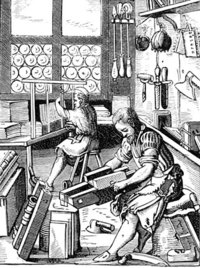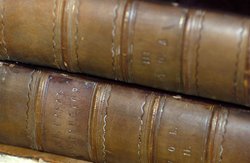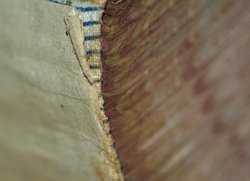Bookbinding
|
|
| Contents |
Historical
The craft of bookbinding may have originated around the 1st century A.D. Romans of the time created a form of simple book called a codex by folding sheets of vellum or parchment in half and sewing them through the fold. Codices were a significant improvement over papyrus or vellum scrolls, in that they were easier to handle, allowed writing on both sides of the leaves, and could be searched through more quickly.
Later books were bound between hard covers, with pages made from paper, or parchment, but were still created by stitching folded sheets at the seam. Since early books were exclusively handwritten on handmade materials, sizes and styles varied considerably, and each book was a unique creation or a copy of it.
With the arrival (from the East) of rag paper manufacturing through Europe in the late Middle Ages and the use of the printing press beginning in the mid-15th century, bookbinding began to standardize somewhat. But page sizes still varied considerably.
Modern commercial binding
There are various commercial techniques in use today. Commercially-produced books today tend to be of one of four categories:
- A hardcover or hardbound book has rigid covers and is stitched in the spine. Looking from the top of the spine, the book can be seen to consist of a number of signatures bound together. When the book is opened in the middle of a signature, the binding threads are visible. Hardcover books are typically of octavo size or larger. Unusually large and heavy books are sometimes bound with wire or cable.
- A paperback book consists of a number of signatures or individual leaves between covers of much heavier paper, glued together at the spine with a strong flexible glue; this is sometimes called perfect binding. Mass market paperbacks and pulp paperbacks are small (16mo size), cheaply made and often fall apart after much handling or several years. Trade paperbacks are more sturdily made, usually larger, and more expensive.
- A cardboard article looks like a hardbound book at first sight, but it is really a paperback with hard covers. It is not as durable as a real hardbound; often the binding will fall apart after a little use.
- A sewn book is constructed in the same way as a hardbound book, except that it lacks the hard covers. The binding is as durable as a hardbound book.
The rise of desktop publishing has brought a fifth form into the commercial market, as well.
- A comb-bound book is made of individual sheets, each with a line of slits punched near the bound edge. A curled plastic "comb" is fed through the slits to hold the sheets together. Comb binding allows a book to be disassembled and reassembled by hand without damage.
Magazines are considered more ephemeral than books, and less durable means of binding them are usual. In general, the cover papers of magazines will be the same as the inner pages or only slightly heavier.
- Perfect binding similar to paperback books is often used; National Geographic is perhaps the best known of this type.
- Stapling through the center fold, also called saddle-stitching, joins a set of nested folios into a single magazine issue; as are most American comic books.
Modern hand binding
When talking about bookbinding as a craft, it is almost exclusively hardbound books that are the subject. When rebinding a sewn book, one usually turns it into a hardbound book by adding hard covers. There are different methods of sewing, such as stab sewing. The traditional method which uses sashes allows the book to open flat and not break the spine. Books can be bound in many different materials. Some of the more common materials for covers are leather and cloth (see also: buckram). A common way to bind a book is as a halfbound book, which means that the spine and the corners of the cover are covered with leather or cloth, while the rest is covered with paper (normally marbled or otherwise decorated).
Terms and techniques
- A leaf is a single complete page, front and back, in a finished book.
- The recto side of a leaf faces left when the leaf is held straight up from the spine.
- The verso side of a leaf faces right when the leaf is held straight up from the spine.
- A folio is a single sheet folded in half to make two leaves.
- A codex is a set of folios nested together and sewn through the fold.
- A signature is a large sheet printed with several pages, intended to form four or more leaves in the finished book. The pages are arranged on the sheet so that all of the pages orient the same way and are in proper sequence after the sheet is folded. Arranging these pages correctly is called imposition. (Signature also refers to a sequence number or code printed on the sheet so that the several signatures that make a complete book may be properly sequenced; this signature is often trimmed off after binding.) The signature may be folded in several ways, depending on the number of leaves it will form; it is then stitched together down the last fold. See also paper size.
- A sheet folded in quarto (also 4to or 4°) is folded in half twice at right angles to make four leaves.
- A sheet folded in octavo (also 8vo or 8°) is folded in half 3 times to make 8 leaves.
- A sheet folded in sextodecimo (also 16mo or 16°) is folded in half 4 times to make 16 leaves.
- Duodecimo or 12mo, 24mo, 32mo, and even 64mo are other foldings of a signature. Modern paper mills can produce very large sheets, so a modern printer will often print 64 or 128 pages on a single sheet.
- Folio, quarto, and so on may also refer to the size of the finished book, based on the size of sheet of that an early paper maker could conveniently turn out with a manual press. Paper sizes could vary considerably, and the finished size was also affected by how the pages were trimmed, so the sizes given are rough values only.
- A folio volume is typically 15" (38cm) or more in height, the largest sort of regular book.
- A quarto volume is typically about 9" (23cm) by 12" (30cm), roughly the size of most modern magazines.
- An octavo volume is typically about 5-to-6" (13-15cm) by 8-to-9" (20-23cm), the size of most modern digest magazines or trade paperbacks.
- A sextodecimo volume is about 4-1/2" (11,5cm) by 6-3/4" (17cm), the size of most mass market paperbacks.
- A quire is a set of leaves which are stitched together. This is most often a single signature, but may be several nested signatures. The quires for a single book are arranged in order and then stitched together as a set.
- Trimming allows the leaves of the bound book to be turned. A sheet folded in quarto will have folds at the spine and also across the top, so the top folds must be trimmed away before the leaves can be turned. A signature folded in octavo or greater may also require that the other two sides be trimmed. Uncut books are untrimmed or incompletely trimmed, and may be of special interest to book collectors.
External link
- How to make a simple hardcover book (http://www.mothteeth.com/bookmaking/)



